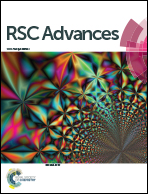Co-cultivation of Synechocystis salina and Pseudokirchneriella subcapitata under varying phosphorus concentrations evidences an allelopathic competition scenario†
Abstract
Microalgae and cyanobacteria have received ample attention in the last few decades due to their environmental and biotechnological applications. Co-cultures of these microorganisms may present benefits particularly on wastewater bioremediation and biomass production. However, the understanding on the interactions between photosynthetic microorganisms is still in an early stage of knowledge. In this line, the aim of the present study was the evaluation of the growth dynamics of co-cultures of a cyanobacterium, Synechocystis salina, and a microalga, Pseudokirchneriella subcapitata, under low phosphate-phosphorus concentrations. Kinetic growth parameters were determined through the Monod and modified Gompertz models and evidence of allelochemical production was confirmed through metabolomic analysis of the supernatant obtained from the co-cultures using GC-MS and 1D-NMR. Kinetic growth parameters have shown that P. subcapitata was better adapted to grow under low phosphorus concentrations. Co-cultivation of these microorganisms did not influence P. subcapitata growth; however, S. salina growth was strongly inhibited. The modified Gompertz model has shown that growth inhibition of S. salina in co-cultures may be related to the activity of allelochemicals produced by P. subcapitata. This assumption was corroborated by the assessment of the antimicrobial potential of lactic acid (2-hydroxypropanoic acid), an organic acid identified in the supernatant from the co-cultures with growth inhibitory effects against S. salina.


 Please wait while we load your content...
Please wait while we load your content...